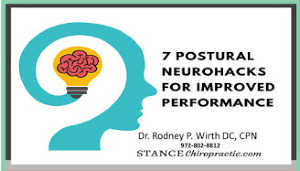How Posture Correction Can Reduce Cognitive Decline in Aging
In this podcast, Dr. Rodney and Karen are guests on Lesley McShane’s podcast called Redesigning Midlife. It was a joy to speak about a vital topic in the longevity theme because there are simple ways to improve your posture.
5 Surprising Ways to Prevent Cognitive Decline through Better Posture
(1) Take consistent posture breaks.
A posture break simply reverses the position you’ve been in for the last 20 minutes – an hour. Most of us are seated and hunched forward. Now it’s time to stand – raise your arms – look up. If your eyes are tired from close work on your devices, put a finger above your head and bring it toward your eyes. Focus until your eyes are crossed.*(It’s a myth that they will get stuck.) Hold for 10 seconds and stare into the distance.
Research: Compared to uninterrupted sitting, short bouts of standing or light-intensity cycling and walking may improve acute cognitive performance.
(2) Move more and do it mindfully.
Some great examples of mindful movement are yoga and Taichi. You can also perform stretches morning and night. Walking with good posture also counts. Be aware of your arm swing to make sure you are using opposite arm/leg movements as when a baby is crawling.
Research: Studies with healthy seniors suggest that physical exercise can improve cognition and quality of life. Physical exercise training leads to improved cognitive functioning and psychological wellbeing in frail older adults. (Langlois et al, 2013)
(3) Stand on one leg while brushing your teeth.
Balancing requires different parts of the brain to fire together, as it takes in sensory inputs from all over the body. The ability to balance may strengthen neural pathways, boosting neuroplasticity (aka the brain’s ability to wire and rewire itself).
Research:10 second balance on one leg predicts survival (all cause mortality) and fall prevention
(4) Engage in active sitting (on a balance ball or posture cushion).
Balancing on a stability ball forces you to engage your core muscles including those in your deep back, abdominal, and pelvic floor. It also keeps your muscles engaged for extended periods of time because you are doing a little extra core work which helps to keep your spine properly aligned and stabilized.
Research: Research has documented that sitting for long periods of time is associated with a higher risk of heart disease, cancer, diabetes, depression and anxiety. Studies have found decreased hip mobility is one of the main reasons that older people tend to fall. Chronic sitters have tight hip flexor muscles and weakening of the legs.
5-Stand-Get a standing desk
Five minutes of standing activities (walking the dog, folding laundry or taking out the trash) for every hour of sitting is sufficient to combat sedentary behavior.
Research: Researchers from UCLA discovered that adults without dementia who spent more time sitting in the day had greater thinning of an area of the brain that is important for making memories (medial temporal lobe).
Dr. Rodney will help you discover the root cause of your health challenges and deliver a personalized treatment plan to restore proper body function and provide hope to achieve your best future.
Your body functions best when you balance the basic elements of health. They are as follows: alignment/posture, nutrition, movement, rest and the belief your body can heal itself once the nerve interference is removed. When all your systems are functioning properly your body will be able to heal itself in what may seem like miraculous ways.
At STANCE Chiropractic we follow the groundbreaking principles of Postural Neurology. Dr. Rodney will evaluate you thoroughly to understand what’s going on from the standpoint of the cranial nerves that control your balance and posture. You will learn the process of Neuro-Rehabilitation movements both when your come to your appointments in the office and at home between appointments.
Many of our patients experience life-long results as they implement small changes every day and begin to move better, live better and achieve things they never thought possible.
Follow us on Instagram.
Follow us on Facebook.








